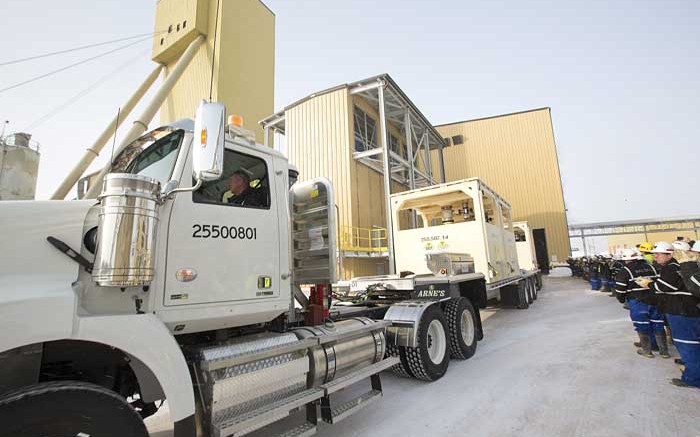Cameco’s (TSX: CCO; NYSE: CCJ) Cigar Lake — one of the most technically challenging mining projects in the world — has started production after years of delays and mine plan re-engineering.
The uranium mine in northern Saskatchewan is owned by operator Cameco (50.025%), Areva Resources (37%), Idemitsu Uranium Exploration Canada (8%) and TEPCO Resources (5%). As of December 2013, the project’s capital costs were estimated at $2.6 billion.
The uranium deposit was discovered in 1981 and construction of the underground mine started in 2005, but development was delayed due to water inflows in 2006 and 2008. The mine was dewatered and remediated in 2011 and construction resumed.
Ore slurry from the mine will be processed into uranium concentrate at the McClean Lake mill, 70 km northeast. Processing could start by July 2014, with the mill producing between 2 million and 3 million lb. uranium concentrate in 2014, and ramping up to its full production rate of 18 million lb. by 2018.
Areva — which is the mill operator — owns 70% of the mill. Denison Mines (TSX: DML; NYSE-MKT: DNN) owns 22.5% and OURD Canada the remaining 7.5%.
Rob Chang, a mining analyst at Cantor Fitzgerald, forecasts that Cigar Lake’s production on a 100% basis will reach 1.4 million lb. in 2014, and notes that Cigar Lake could become one of the world’s largest uranium mines — making up 9% of global mine supply by 2018. But he forecasts a “large and unavoidable supply deficit commencing in 2019.”
The mining method, known as jet boring, was a technique developed for the Cigar Lake deposit and involves drilling a pilot hole into the frozen orebody, inserting a high-pressure water jet and cutting a cavity out of the frozen ore. The ore-and-water “slurry” is then collected from the cavity and pumped into a storage tank where it settles. The ore is excavated from the storage tank using a clamshell and transferred to a grinding-and-processing circuit, loaded onto a tanker truck and moved to the mill. Once the slurry is extracted, the cavity in the orebody is backfilled with concrete and the process begins again in the next cavity.
At full production, two jet-boring machines will mine at the same time, and another pair of the machines will be deployed to other parts of the mining sequence, such as backfilling and moving to the next mining cavity location.
Cameco notes that the method has not been proven at full production and “there may be some technical challenges that could affect our production plans.”
The deposit occurs at depths ranging from 410 to 450 metres below the surface, where water-saturated Athabasca sandstone meets the underlying basement rocks. The sandstone that overlies the deposit and basement rocks holds large volumes of water under high pressure.
To prevent water from entering the mine and help stabilize weak rock formations, the company explains, the ore zone and surrounding ground for mining is frozen by circulating a brine solution through freeze holes drilled from both surface and underground. The area being mined must meet ground-freezing requirements before jet boring can start, and the company notes that bulk freezing “reduces but does not eliminate the risk of water inflows.”
David Sadowski of Raymond James writes in a research note that the start of mining and underground processing circuits at Cigar Lake “sends a positive de-risking signal to the market,” which “has taken a cautious approach to the operation following two major water inflow events in 2006 and 2008.”
Sadowski says that “though not out of the woods completely at the mine [with some risk to ramp-up towards full run rates) or at the mill [with leaching-circuit modifications on track for completion by June 2014E], we believe investors will view the development as a partial validation of jet boring as a viable means to extract uranium from the world-class Cigar Lake orebody — the largest undeveloped high-grade deposit globally.”
As of Dec. 31, 2013, Cigar Lake’s proven and probable reserves measured 537,100 tonnes grading 18.30% uranium oxide (U3O8) for 216.7 million lb. U3O8 (Cameco’s share adds up to 108.4 million lb. U3O8).
Measured and indicated resources stand at 44,400 tonnes grading 2.27% U3O8 for 2.2 million lb. contained U3O8 (Cameco’s share is 1.1 million lb. contained U3O8).
Inferred resources add 373,400 tonnes averaging 12.01% U3O8 for 98.9 million lb. contained U3O8 (Cameco’s share is 49.5 million lb. U3O8).
Decomissioning costs on a 100% basis are expected to reach $49 million.


Be the first to comment on "Production underway at Cameco, Areva’s Cigar Lake"